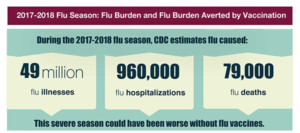 The Centers for Disease Control and Prevention and the National Foundation for Infectious Diseases launched their annual influenza vaccine campaign on Sept. 26 as reports are emerging that Americans may be facing a severe season this winter.
The Centers for Disease Control and Prevention and the National Foundation for Infectious Diseases launched their annual influenza vaccine campaign on Sept. 26 as reports are emerging that Americans may be facing a severe season this winter.
Flu season in the U.S. officially begins Oct. 1 and emergency room doctors have anecdotally reported that they are starting to see more people arriving in hospitals with the flu and two people in California, including a 4-year-old child have already died from the flu.
“That gave everyone a chill … that is distinctly early for us,” Dr. William Schaffner, medical director at the NFID and an influenza expert at Vanderbilt University told HealthLine.
Because flu circulates during colder seasons, U.S. researchers look to the Southern hemisphere, where winter is just ending, as one early predictor of what might happen in the north. Australia has had one of its worst flu seasons on record this year.
“Although it is too early in the U.S. to make predictions, parts of the Southern Hemisphere, where flu season is winding down, had relatively active flu activity,” said Richard Webby, director of the World Health Organization’s Collaboration Center on the Ecology of Influenza in Animals and Birds and a researcher at St. Jude Children’s Research Center in Memphis.
Webby is one of several scientists who are responsible for choosing the make up of the flu vaccine annually. He is constantly surveilling worldwide flu activity. There are multiple strains of constantly mutating flu virus circulating around the world, requiring public health officials to update the vaccine annually.
Around 36,400 and 61,200 people in the U.S. died from the flu during the 2018-19 flu season and as many as 647,000 were hospitalized, according to the CDC. This is down from the previous year when about 80,000 died and almost 1 million were hospitalized. The 2017 to 2018 flu season was one of the worst in terms of the number who were sickened and died from the flu, in a decade.
“Many people underestimate the severity of the flu, yet we know flu causes hundreds of thousands of hospitalizations and tens of thousands of deaths each year,” said Alex Azar, secretary of the Department of Health and Human Services Secretary, at the CDC news briefing about the upcoming flu season. “Our best preventive tool is an annual flu vaccine.”
About half of Americans, however, are unlikely to do so. At the CDC news briefing, Schaffner unveiled an NFID-sponsored poll, which found that only 52 percent of adults plan to get the flu shot because they don’t think the vaccine works, because they are concerned about side effects, or because they falsely believe the shot will give them the flu.
Last year, the flu vaccine was only about 29 percent effective, but Schaffner noted that the flu shot shortens the duration of illness, even if a person does get sick. Further, it can reduce side effects from the flu, such as inflammation and vulnerability to an even more serious illness like pneumonia or a heart attack.
“Those who get the flu are six times more likely to have a heart attack,” said Dr. William Borden, George Washington University School of Medicine & Health Sciences’ associate professor of medicine.
And the flu shot was more effective — about 45 percent — in children, said Patricia Whitley-Williams, M.D., Rutgers Robert Wood Johnson Medical School’s chair of pediatrics. Still, there were 135 pediatric deaths associated with the flu in the last flu season.
“I remember last year … I was with a mother whose 9-month-old daughter … had the flu … and was on a ventilator and she said to me ‘I could have prevented this,’” but she hadn’t given her a flu shot, Whitley-Williams said. “We need to educate parents about the importance of vaccines.”
Last year’s vaccine was less effective because two different waves of the virus infected people, and the shot wasn’t as effective against that second wave. Public health officials are hopeful they have better matched the flu shot for this coming season.
Meanwhile, the Trump administration, on Sept. 19 signed an executive order creating a task force to improve the manufacturing of the flu vaccine and encourage the use of cell-based technologies. Currently manufacturers grow the vaccine in eggs – a decades-old technology – because drug companies would have to invest millions in retooling their manufacturing to use cell-based tools.
Azar, who told reporters he’d been working on improving the flu vaccine since he worked for former president George. W Bush, said the executive order ensures an “influenza infrastructure” that organizes federal efforts to improve the vaccine. He said he expects Congress will provide funding for the effort in future budgets.
For reporters looking for tips to cover this coming flu season, see AHCJ’s infectious disease core topic page and this tip sheet with a list of experts vetted by AHCJ.
- Season Flu Resources for 2019-2020 Flu Season – AHCJ, September 2019
- National Poll: Attitudes About Flu and Pneumococcal Disease – NFID, September 2019
- Crikey! Australia Flu Season Was Bad, What Does That Mean for The US – Healthline, September 2019
- Why You Need the Flu Shot Every Year – New York Times, December 2017






